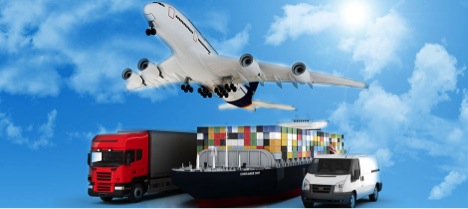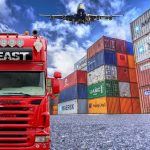2021 Freight Rates & International Shipping Outlook Part 2 – Intermodal Prices
Today we continue our examination of freight rates and the outlook of the international shipping industry for 2021. Part 1 of this series looked at the high freight rate prices the international shipping market is seeing right now, particularly for transpacific ocean freight cargo from China to the U.S. Additionally, we looked at cargo volume, how it is trending, and the potential for a crash.
As we continue this examination, we look at what’s happening with intermodal shipping, considering how truck and rail for getting containers to and from the ports is affecting importers and exporters’ bottom lines.
Intermodal Prices Up

We’ve put a great deal of focus on how high ocean freight rates are, but truck and rail rates have also increased, making intermodal prices, in general, higher for shippers (not just because they’re paying more for ocean freight rates). That makes sense with the increase in cargo volume we’ve seen over the last six months combined with a trucker shortage. Increased demand paired with a decrease in supply should result in higher prices every time (unless regulatory intervention comes into play, which usually doesn’t turn out well in the long run).
In our desperation to find truckers to deliver shipping containers from the ports to businesses or vice versa, Universal Cargo offered extra money to get our customers’ goods taken care of and protect them from demurrage and detention fees.
Ari Ashe reported last week in the Journal of Commerce (JOC):
Shipper costs will rise more than 10 percent for intermodal service in certain US markets to support investment in new containers, drivers, and other equipment designed to ease the congestion woes seen last year, J.B. Hunt Transport Services said Tuesday.
Factors Increasing Intermodal Costs
Factors pushing truck and rail costs up are not going to disappear instantly, meaning the cost increases are not likely to reverse soon. The congestion factoring into higher costs, which we’ve talked about extensively in recent posts, will take some time to alleviate. However, the congestion will ease much faster than the trucker shortage problem will take to resolve.
We’ve posted about the trucker shortage off and on for years. It is a long-term, ongoing problem. The trucking industry is banking on automation to eventually solve it. The automation solution that I think has the most promise right now is seemingly driver-less trucks that are actually driven remotely. We blogged about such an unmanned, automated truck being tested in traffic back in 2019. However, even if the technology is almost ready, there are many regulatory hurdles that would have to be cleared before automated trucks can even go into mass production to even begin solving the trucker shortage issue.
The container shortage, along with availability of equipment like chassis to move the containers, is a major issue driving up costs right now. It’s something of a destructive cycle as the container shortage factors into congestion and the congestion factors into the container shortage. Recent and new container orders and the easing of congestion that is coming will likely see container availability back under control within the next couple months; however, increased container costs have been a significant issue for shippers recently. These costs are seen in increased freight rates, both over the ocean and by truck and rail.
Shippers have felt the effects of this shortage through delays in being able to ship, rate hikes, and detention and demurrage fees.
How Long Before Truck and Rail Prices Come Back Down?
Truck and rail prices vary regionally, and the increases are significant. Ashe shared some data of what has and will likely happen with intermodal prices in the previously quoted JOC article:
Prices will likely grow more than 10 percent in the Los Angeles market — the epicenter of congestion in 2020 — based on conversations with non-asset intermodal marketing companies (IMCs). Domestic intermodal volume out of the Southwest surged 17.2 percent year over year in the fourth quarter.
As discussed above, the trucker shortage puts upward pressure on trucking rates and will continue to do so for some time. However, the biggest factor in prices is often demand. Demand is higher than usual and appears likely to stay that way for at least another month or two (and potentially longer). The longer the congestion lasts, the more demand is felt on trucking and rail. There’s no reason to think the increases in price that are happening will come down right away.
If the possible crash we discussed in the last part of the series happens, that would obviously put extreme downward pressure on intermodal prices. However, I don’t expect drops in trucking and rail rates in the next month or two while port congestion is being tackled and the latest stimulus likely sparked a fair bit of spending to help demand stay strong a little bit longer.
There are signs American spending on goods that has pushed the high volume demand could really start slowing. There are some easings of restrictions happening as thing like California’s Governor Gavin Newsom is feeling the recall pressure and alleviating some of his severe lockdown policies and New York Governor Andrew Cuomo has had a sudden change of heart to start saying things like the cost is too high to stay closed and wait for the vaccine. This could lead to a portion of American consumer spending shifting back from purchasing goods to going out again. It is certainly good news for businesses being allowed to reopen that have managed to survive shutdowns so far.
Unless we see a crash in a few months from all the jobs lost and businesses that can’t reopen, at that point truck and rail prices should fluctuate up and down some with the rises and falls in demand. However, truck and rail rates do not tend to be nearly as volatile as spot ocean freight rates (of course, carrier control on the industry through alliances may have put an end to ocean freight rate volatility as we’ve known is). For truck and rail, the starting point when we do start seeing up and down fluctuation will be these higher rates we’re at and about to get to now.
Continued in Next Post
There’s more happening with 2021 international shipping, including an unusual year for factory operations in China during the upcoming Chinese Spring Festival Holiday. We’ll get to that and more as this series continues with the next post in Universal Cargo’s blog.



